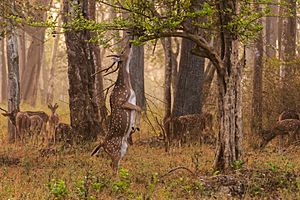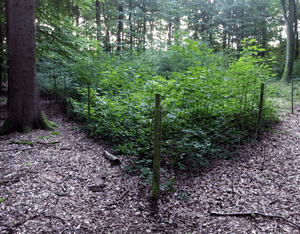Browsing (herbivory) facts for kids
Browsing is when an animal eats leaves, soft shoots, or fruits from tall plants like shrubs and trees. These animals are called browsers. It's different from grazing, which is when animals eat grass or other low-growing plants. Think of it this way: goats are browsers because they like to eat leaves from bushes, while sheep are grazers because they mostly eat grass. Both are ruminants, but they prefer different kinds of food!
What is Browse?
The plant material that browsers eat is called browse. Animals usually eat it directly from the plant. However, people who raise animals like goats or deer sometimes cut twigs and branches for them to eat.
In places with cold winters, farmers might collect browse before the leaves fall. They dry it and store it to feed their animals during winter. In dry areas, if there isn't much food on the ground, people might cut branches from trees that are too high for their animals to reach. This helps feed the animals, but if done too often, it can harm the plants in the long run.
Animals in zoos or wildlife parks are also fed browse. For example, pandas might eat banana leaves, bamboo shoots, or branches from pine and willow trees.
How Browsing Affects the Environment
If too many browsing animals live in one area, they can eat all the reachable plants. This creates a clear line on trees and shrubs where no leaves are left. This line is known as the browse line.
If animals keep eating too much (this is called over-browsing), it can stop new trees from growing. Young plants might not survive long enough to grow tall enough to be out of reach of the browsers. This can change the entire ecosystem over time.
Images for kids
-
A White-tailed deer browsing on leaves in Enderby, British Columbia.
See also
 In Spanish: Ramoneo para niños
In Spanish: Ramoneo para niños





